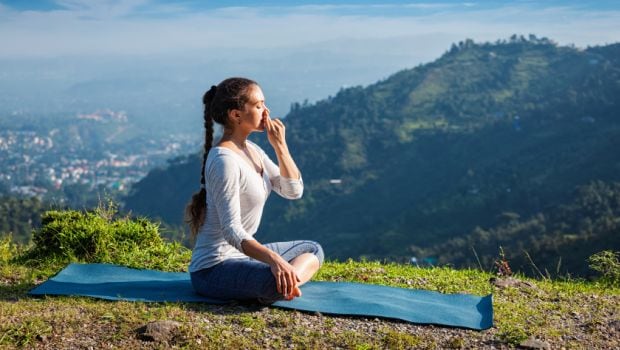How to Do Meditation: A Beginner’s Guide

When was the last time you sat down in a quiet corner with complete awareness of yourself, your breath and your immediate surroundings? Not in a really long time, isn’t it? We’re so used to ‘multi-tasking’ in our daily lives that being consumed with myriad thoughts, all at once, has become second nature to most of us. We’re zipping through meetings, taking work home, working while on vacation and thinking about the next break when at work. It’s a stressful life and we only have ourselves to blame for it.
So, what is the solution and is there really a way out?
Luckily, there are many practices out there that can help calm a stressed mind and body. Meditation is one such practice. It is an inexpensive tool that has infinite benefits. All it asks in return is for you to be patient and consistent. Trying a few times and giving up is just what you need to avoid if you are serious about picking up this ancient way of relaxation. This is not something you will learn overnight. But if you keep at it then the benefits of mediation can be reaped over a lifetime.
What is meditation?

The word ‘Meditation comes from the Latin root ‘meditatum’ which means ‘to ponder’. Meditation can be described as a practice that helps silence the mind. Some even describe it as a state of ‘thoughtless awareness’ – a condition where your mind is free of the non-stop tick-tock of thoughts while being completely aware of yourself.
History of Meditation
The earliest mention of Meditation or ‘Dhyana’ was in the Vedas. Ancient India is known to be well acquainted with the practice meditation and it was only around the 5th and 6th BC that other forms of meditation developed in China and later in Japan. The last century has seen meditation become a global phenomenon with various masters coming up with their unique styles and techniques.
How does meditation work?
The Autonomic Nervous System (ANS) is a part of the Central Nervous System and regulates unconscious functions like the heart rate, digestion and respiration. The Autonomic Nervous System is further divided into Sympathetic and Parasympathetic Nervous Systems. Sympathetic Nervous System (SNS) is what is responsible for activities which have a ‘flight-or-fight’ response. Anger, fear, fatigue, stress or in an extreme situation ‘a threat to survival’ – these are the times when the SNS is most active and hormones like cortisol are produced. Meditation calms the Sympathetic Nervous System and activates the Parasympathetic Nervous System or the ‘good’ nervous system. Over a period of time, this regulates the heart rate, blood pressure, sweating among other benefits.
(Top 10 Natural Foods to Control High Blood Pressure)
Benefits of Meditation

Thousands of scientific studies have been done around the benefits of meditation. They have all confirmed what Indians have always known – that meditation is a holistic approach to a happy body and mind.
1. A healthier body
2. Improved breathing
3. Increases energy levels and helps improve immunity
4. Helps control and regularise heart rate and blood pressure.
5. Regulates production of stress-hormones like Cortisol by soothing the Sympathetic Nervous System.
6. Helps focus and concentrate better
7. Reduces anxiety and stress
8. A greater ability to face tough situations
Meditation for beginners
You don’t have to give up on your favourite foods or stay away from your loved ones if you chose to take up Meditation. In fact, if you have hectic schedule and it feels like hours just whizz by – then meditation is just what the doctor ordered. If you have just started to meditate it will be extremely difficult to sit for hours in a relaxed state of mind. Be practical and don’t have such expectations from yourself initially. Experts say the easiest way to begin is by focusing on your breath and try and increase the duration gradually.
Here are 5 simple steps to start meditation:
1. Where? Any part of your home works as long it is quiet and there is no hustle-bustle around. Make sure the place you pick is also well-ventilated.
2. When? Mornings are suggested by most experts simply because meditation allows you to start off your day on a good note. Having said that, meditation can be done anytime of the day! Don’t go by what others tell you – if middle of the day works for you then go for it. Find a routine that works for you but be regular. A few minutes every day will go a long way in your efforts to master this art.

3. Don’t meditate on a heavy stomach. You don’t want to put yourself to sleep or feel drowsy. At the same time, avoid doing it just before meal-times. The idea is to find a spot in your daily schedule when you are relaxed and not distracted.
4. Close your eyes. Try to ‘collect’ your thoughts and put them away for a little while. Consciously tell yourself that for this short period of time you will not think about anything else. Take a few minutes and normalise breathing and don’t rush into things.
5. Start by focusing on your breath. Breathe normally for a few times. If it helps count the number of breaths you take, to begin with. Mediation starts first by controlling your mind to ‘concentrate’ on one thing and not wander off. As you learn to control your thoughts you will find it easier to get into in a ‘thoughtless’ state, and then to stay there longer. Each time your thoughts run away to another topic, you must ‘come back’ to focusing on your breath.
[“source-ndtv”]